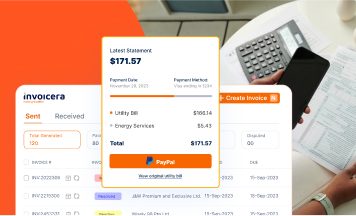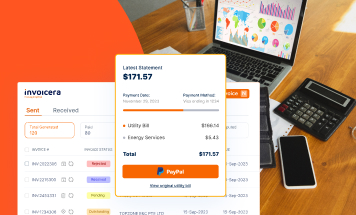Introduction
The business landscape has changed forever because of cloud-based systems and technology. Cloud-based invoicing, for one, helps small businesses stay financially healthy.
Many business owners overlook the importance of their invoicing systems, which is understandable as their focus is often on networking, strategizing, and boosting sales. However, even with success in these areas, the financial health of a small business can falter without an efficient invoicing system. In this article, we’ll tackle how cloud-based invoicing is the solution and will discuss the numerous benefits these systems can offer your business. Let’s dive in.
Common Small Business Invoicing Issues
First, let’s understand the common issues with invoicing.
1. Missing Invoices
Your clients are dealing with all kinds of operational issues, just like you are. So, it’s natural for them to misplace or forget about an invoice from time to time. This can cause delays in payments (more on that later) or even accounts payables neglected.
In some cases, some business owners might not have their own copies of these invoices. Other times, the duplicate gets buried somewhere only to never be found again.
2. Late Payments
54% of small businesses experience late invoice payments. And with late payments come all kinds of operational problems, such as operational deficits, cashflow problems, and unnecessary stress and anxiety for business owners and their finance teams.
It takes one late payment to cause a domino effect of late invoices. When left unchecked, the business could start losing money because of poor payment-chasing rhythms. Sometimes, relying on human talent to pursue late payments might not always be the best solution. They’ll run out of creative ways to pursue invoices and occasionally forget one or two follow-ups.
3. Invoice Errors
Very much connected with late payments, invoice errors can be another common invoicing problem for small businesses. Typographical errors, wrong computations, and other errors will result in non-payment, which will delay your invoicing.
If the client doesn’t double-check, you can also have several accounting problems when they underpay or overpay you. Plus, it will lower your credibility and trustworthiness when clients and customers find out they paid the wrong amount because of a supplier-side error.
4. Slow and Complex Finance Processes
Legacy payment systems, complex finance processes, and so on add unnecessary work to finance committees and staff. What could be a five-minute billing task could become hours if your systems aren’t as streamlined as they should be.
The worst attitude towards these invoicing problems is to say, “They’ve always been this way, so might as well take it as it is.” Cloud-based invoicing has several solutions to these recurring pain points..
Top Cloud-based Invoicing Features for Small Businesses
1. Automated Invoice Creation and Dispatch
You can set up recurring billing for clients with your cloud-based invoicing software You can schedule intervals on when to send invoices automatically. With this, invoices and—concurrently—payments go out as scheduled with little to no manual intervention. This saves your time and reduces the chances of human error, and ensures invoices are sent on time.
2. Customizable Templates
Customizable invoice templates are available on most cloud-based invoicing tools. You get to add and use your own business logo, information, payment terms, and more. Using templates helps you maintain brand consistency and professional appearance while accommodating different billing scenarios.
3. Integrated Payment Processing
It’s always best to go for an invoicing system that Includes built-in capabilities to accept payments directly through the invoice. Examples are credit cards and bank transfers. You can also include a PayPal option, which has over 426 million active accounts at the end of 2023.
4. Real-Time Financial Reporting
Financial reporting lets you project revenues for the future, make better money decisions, and celebrate past performance. Invoicing systems have financial reports generated automatically based on invoice data. That can include profit and loss statements, expense reports, and tax summaries.
5. Multi-Currency and Language Support
As the world globalizes, you need to consider billing global clients in their local currencies to win them over. Invoicing in multiple currencies and languages opens businesses up to international markets. This expands your market reach while enhancing customer satisfaction and compliance with local requirements.
6. Data Security and Backup
Invoicing software should always come with security measures like data encryption and regular backups to protect sensitive financial information. Many of these fintech companies go through the security process with a fine comb to ensure top-level data and financial security. Knowing your business data is secure and can be recovered in case of failure or cyberattack gives you peace of mind.
7. Customer Management
Many invoicing and billing tools integrate with tools for managing customer information. You can connect your system to CRMs that handle contact details, billing history, and payment preferences. The clear benefit of this is the streamlined customer interactions you’ll have with paying clients. The integration also provides valuable insights into customer behavior and payment patterns.
Pros and Cons of Using Cloud-based Invoicing
Cloud-based invoicing systems offer several advantages and also some drawbacks. You need to know and understand both to see how far the system can take you. Here’s a detailed look at the pros and cons:
Pros
- Accessibility: Installing invoicing tools ensures easy accessibility. Your team, including remote or on-the-go staff members, can manage invoices from anywhere with an internet connection.
- Cost-Effectiveness: The upfront cost is typically lower compared to traditional on-premises software. Plus, the subscription model often covers updates, maintenance, and customer support, which offers long-term value for your investment.
- Automatic Updates: Your invoicing tool automatically handles software updates. Manually updating your system is a thing of the past. It’s crucial to ensure the system has up-to-date features and security settings.
- Scalability: Cloud-based invoicing platforms scale automatically. This means they can handle higher invoicing volumes over time as your business grows or handle additional features without the need for expensive hardware upgrades.
- Integration: These invoicing platforms easily sync with your existing business tools like CRM software and accounting systems. It eliminates manual work and improves operational efficiency.
Cons
- Dependence on Internet Connectivity: SaaS-based tools rely on consistent Internet connectivity. Any disruptions in your internet connection could temporarily stop operations in your invoicing system and halt your business operations.
- Ongoing Costs: While the initial investment cost may be lower, monthly subscription fees can accumulate over time. It’s essential to weigh these ongoing payments against one-time upfront fees which benefits your business more in the long run.
- Limited Customization: Some invoicing platforms may limit customization compared to traditional solutions. If your business requires highly tailored invoicing processes, especially for bigger organizations, look out for tools with unlimited customization options. These are mostly offered on custom plans.
- Vendor Lock-in: Switching between providers isn’t always straightforward. Potential challenges with data migration and system compatibility could limit your flexibility. Consider the long-term implications of vendor lock-in before implementing a new SaaS invoicing solution.
Best Practices When Using Cloud-based Invoicing
Simply having cloud-based invoicing software isn’t enough. You also need to learn how to use them well. Here are some best practices to follow when utilizing cloud-based invoicing systems:
1. Regularly Update and Secure Your Account
You need to ensure all software updates are applied, and use strong, unique passwords combined with two-factor authentication. This way, you can keep your system secure from unauthorized access and protects sensitive financial data.
2. Customize Invoices to Reflect Your Brand
If you have access to customizable templates to add your logo, color scheme, and any other branding elements, use those as often as you can. It will enhance your professionalism and brand recognition. Moreover, they will make your invoices immediately identifiable to your clients, so they pay you faster.
3. Automate Where Possible
Set up automated billing for regular customers and use automatic reminders for due payments. If they’re amenable to an automated billing system, this will work to your advantage, too. Such automation will save time, reduce administrative burdens, and help maintain a steady cash flow.
4. Take Care of Your Financial Records
We recommend using your cloud system to store and manage all invoicing records, including client details, payment terms, and transaction history. Even though cloud systems typically back up data automatically, they keep additional backups in different locations. That will give you an extra layer of security and data redundancy and safeguard against data loss due to unforeseen circumstances.
7. Ensure Legal and Tax Compliance
Stay updated on relevant tax regulations and legal requirements affecting invoicing in your jurisdiction. Legal issues can be costly. Thankfully, your invoicing tool will help you stay compliant with local tax laws and audits.
8. Train Your Staff
Provide training for all team members who will use the invoicing system. Some of the basics you should cover include creating, sending, and managing invoices. Hire competent staff who know or are willing to learn the system. You would also do well to upskill your finance staff. Ask them which bookkeeping certification is best for your invoicing software and invest in training.
Start by choosing Invoicera to save time and speed up your processes.
Better Systems for Better Business
Business isn’t only about creating great products and marketing them effectively. You also need good administrative processes in place, invoicing being one of the most crucial. If you haven’t implemented an invoicing system yet, it might be time to do so. The outcomes will most likely be positive for you if you consider all the abovementioned considerations and follow best practices. Best of luck!
FAQs
What are the benefits of cloud-based invoicing software for small businesses?
It helps small businesses manage their finances efficiently with the following:
- Automate creating and dispatching invoices
- Integrate payment processing
- Offer real-time financial reporting
- Give better security for your files
What are the best practices for utilizing this tool?
- Secure your account with strong passwords and 2FA (two-factor authentication)
- Reflect your brand identity by customizing invoices
- Comply with legal and tax requirements
- Maintain financial records
What should small business consider in choosing an invoicing solution?
It’s different for each business needs, but here are some important factors to consider:
- Ease of use
- Customization options
- Integration with your existing systems
- Security features
- Cost of the system and your budget








